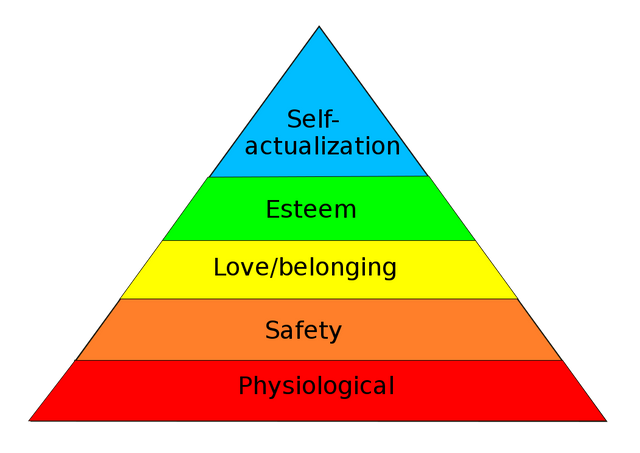The psychological implications of financial autonomy
Maslow’s Pyramid - what drives people?
In 1943, Abraham Maslow introduced a theoretical hierarchy of needs that has since been taught in psychology classes all around the world. For those who are not familiar with this pyramid, it recognizes not only what people strive towards for an ideal existence, but also the order in which these “needs” must be recognized. For most of the developed world, large portions of this pyramid are almost guaranteed to be fulfilled without any incredible level of effort.
- Physiological needs are at the very bottom and have to do with providing yourself with food, water, rest, and any other essentials to live.
- Safety is the second tier and has a lot to do with personal and financial security as well as health. Financial security for this level of the pyramid might look like a stable income that covers your fixed costs of living and insurance plans to assure you will not get ruined financially if unforeseen circumstances cause damages to your belongings/finances.
- Love and belonging make up the third tier. This is fulfilled by forming relationships with friends/family and feeling a sense of belonging among peers.
- Esteem is the fourth level, which generally comes in the form of respect and recognition from others.
- Self-actualization is the pinnacle of his original pyramid (later he identified that there may be a higher level called “self-transcendence”) where you finally reach what you perceive to be your ideal worldly potential.

If you think about the latest generations and where they exist on the pyramid as they enter adulthood, they typically start with all physiological needs provided and easy to maintain as well as their safety needs. Social belonging can be streamlined due to how interconnected we are via the internet. Many people rocket through these first levels of the pyramid by very young adulthood. Where people rank on Esteem may vary quite a bit, but there certainly are many who have a firm grasp on this portion of the pyramid in young adulthood as well. If people have the drive and vision, they can ascend the pyramid to the point of working on self-actualization at a very early age not seen as often at such a young age in previous generations. The primary reason for this is the introduction of new innovations to remove barriers over time.
The premise of self-actualization is all based around knowing what you want out of this world and achieving it. There may be many facets to this goal but one that seems rather universal is an expansion of the financial security from the second tier to a point of financial freedom. This means securing your financial future so you can live life not worrying about if you’ll be prepared for a fun and fulfilling retirement. Historically and very much so in today’s world, achieving financial freedom to this level takes years of cat and mouse, gaming the system, and tedious planning and re-positioning. You either try to go down this journey as an employee positioning for raises/promotions or as an entrepreneur. Entrepreneurship has always had massive barriers to entry and requires a lot of risk.
The case for financial autonomy
In an ideal world, we want to effectively remove as many barriers to self-actualization as possible so people can control their own destiny without outside forces or restraints holding them back. Right now, one common area of resistance in reaching self-actualization has to do with the financial freedom to truly pursue ones ambitions within the top levels of the pyramid. We effectively learn valuable skills as we grow up but there’s never been a clear cut low risk high reward path towards putting those skills to market independently. Any independent option that could help us in our progress to self-actualization is filled with risks.

A huge stride was taken towards financial independence when Bitcoin entered the market using blockchain technology. Bitcoin laid the framework towards financial independence in the realm of truly owning your own resources in a trust-less, peer-to-peer market. This technology is on a clear cut path to removing some of the barriers that one might encounter. If you want to sell a product online, you can do so without needing a third party for payment services by simply accepting Bitcoin or one of many other cryptocurrencies that came to market after its release. This has opened some options for entrepreneurship by lowering some of the transaction barriers associated.
A Crafty method of breaking barriers
Unfortunately, Bitcoin did not make the initial process of kicking off a business and getting your name out there any easier. This is where Crafty comes in. Crafty provides a platform for a contractor to view service providers and negotiate terms for a job. This means that if you have experience in a service related field, you can build a profile on the Crafty platform and begin taking jobs. Once you have completed some jobs, you will have a reputation score that other contractors can see. This means if you do good work and agree to reasonable payment terms, people will give you good ratings and others will be more likely to request your assistance with future jobs. This gives you a venue to fast-track your personal financial independence by allowing you to easily be your own employer. It also simplifies the transition into self-employment by allowing you to control how many jobs you accept. This means you could begin working through Crafty while still being employed part or full time. Keeping your fixed income and adding your independent work in slowly can ease the financial stress of the transition to self-employment as you build a reputation.

There’s also a use case for those in less ideal situations where perhaps they are on the second level of the pyramid chasing security. For those who grow up in less fortunate situations, the ability to build a reputation and take jobs independently could be of incredible value when steady income and financial security are more elusive. In both cases, the intriguing proposition to me is not only the obvious use case of streamlining the self-employment economy, but the idea that this platform could directly tackle some of the barriers to self-actualization.
People tend to forget that there are diminishing returns on happiness stemming purely from money. A study by Marist Poll in 2012 indicated that in the United States, there is a tipping point at around $50,000 annual income where most of the utility needed purely from money gets actualized and subsequent earnings have less of an impact on your happiness. The reason I find Crafty so intriguing is that it is a tool that can be used to streamline your way to that happiness tipping point using skills you already possess which positions you to focus on self-actualization much sooner than if you had to go through traditional channels. In addition, you’re earning this money by providing a service of your choosing. The ability to take something you enjoy doing and build up your own business could easily eclipse the utility you get from the money if you find yourself extraordinarily successful.

One final thought on this project. There are many niche markets out there where people can find some success, but products that hit closer to the core of Maslow's pyramid and have more universal utility tend to create the largest demand. Crafty stands to benefit greatly simply due to the aforementioned ways in which it compliments the pyramid. I'm excited to see how this initiative impacts the country of Brazil and eventually cascades worldwide!
@OriginalWorks contest link
crafty2018
Submitted.